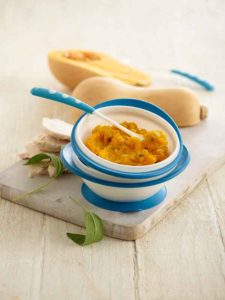
Some amazing first foods to offer your baby during the winter months
With thanks to Annabel Karmel
Taking your first steps into the weaning world can be quite daunting, especially when you are faced with mountains of conflicting advice and opinions. For 25 years, I’ve guided millions of new parents through every stage of feeding and now I’m delighted to be sharing my expertise and inspiration with readers.
Winter is a great time to wean. The supermarket aisles are lined with seasonal fruit and veggies, many of which make for brilliant first foods. From carrots to pumpkin, parsnips to butternut squash, let’s get those bibs on and sleeves rolled up!
When to start weaning
Breast milk provides all the nutrients your baby needs for the first six months, when the Department of Health states babies should start weaning. Babies develop at different rates and if your baby is showing signs of being ready to move on from just breastfeeding, then you could try some simple solids.
Transitions to solids are more about introducing food than giving a full meal. Parents sometimes make the mistake of giving food when their babies are hungry, when really they need a milk feed. Giving too much purée too quickly may lead to constipation.
Up until now your baby has been comfortable with milk alone but if you spot signs
of them being hungrier than usual, even after their milk feed, or waking in the night, it may be an indicator that they’re ready to move on.
Babies between the age of six and 12 months should still have 500 to 600ml of milk a day. Breast should be given as your baby’s main milk as it’s richer in vitamins and iron than cow’s milk – however you can give cow’s milk in cooked food from six months. Stick to full-fat milk as the calories will help fuel your baby’s growth and perhaps start to give some expressed milk in a cup.
Really rooty
Root vegetables are at the very core of weaning. They’re easy to digest and unlikely to provoke an allergic reaction. The best way to cook them to preserve their nutrients is to steam them so that they puree into a smooth texture. Sweet potato, butternut squash and parsnips are great because they have a naturally sweet taste, a similar sweetness to breastmilk.
Combining fruit with savoury tastes was my secret weapon when I was weaning my son Nicholas. He liked eating apples but wouldn’t eat chicken, so I made combinations like chicken, sweet potato and apple, which he loved.

Fabulous fruits
Choose ripe fruits with a good flavour; taste them yourself before giving them to your baby. Good first fruits are apple and pear, steamed or cooked in a saucepan. Some fruits like banana, avocado, peach and papaya don’t require any cooking – just mash with a fork.
Once you have introduced single ingredient purées, you can make combinations like apple and pear, avocado and banana or peach and banana.
Be prepared
Planning ahead is great for ensuring you have everything you need and can save you stress on a busy day. Batch cooking was my saviour! It can be difficult to blend a small quantity of food, so prepare purées in large batches and freeze individual portions in ice cube trays. Be sure to label them clearly with the contents and date so you don’t get them muddled up and start serving a sh puree for breakfast!
When it comes to defrosting, take the puree out overnight and reheat in a saucepan or microwave – stirring thoroughly to remove any hot spots. Never refreeze a puree that has already been frozen and do not reheat foods more than once.
And – you’re off!
You’ll soon be on the road to weaning victory! Here are my top tips to help you:
- Invest in a weaning spoon. Babies instinctively push their tongue forwards when you put something in their mouth, so to help them swallow, use a shallow weaning spoon. If she can’t get on with it, dip a clean finger in the puree and let her suck it.
- How to blend. I generally blend baby purées using a hand held electric blender. However this doesn’t work for potato, which becomes sticky as the starches break down. Put potato through a mouli, hand turned blender or ricer.
- Get into a routine. It’s a good idea to choose a spot where you’ll be regularly feeding your baby, so that she begins to associate it with mealtimes. The kitchen is probably best, as she’s bound to make a considerable mess for the rst few months – or even years!
- Have fun. Remember to laugh, smile, sing and taste your baby’s food as she’ll want to join in the fun by copying you and eating it herself.
- Give new foods at lunchtime. Try new foods around lunchtime so that their evening sleep isn’t disturbed and you can have a peaceful night as the darker evenings draw in (well… hopefully!).
- Introduce finger foods Once your baby is able to hold food in her hand and chew, you can try giving soft finger foods like banana or pear that dissolve in the mouth. The more you allow your baby to experiment with feeding herself the quicker she will master the art.
Happy weaning!
Some link you may like
How to add taste and texture to your baby’s first foods
Finger foods for your little one
